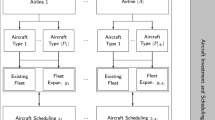Abstract
The “size” of a production facility has different specific meanings depending on the nature of the business decision at issue. We present a general theoretical model illustrating the profit-maximizing firm's interrelated choice of plant size in long-run, medium-run and short-run contexts. The model is then estimated for U.S. airline hubs. The results suggest that competition operates primarily via the capacity (long-run) size decision. A game-theoretic simulation based upon the results is consistent with the argument that the smaller of two hubs sharing an airport is at a significant competitive disadvantage.
Similar content being viewed by others
References
Bailey, Elizabeth E., and John C. Panzar (1981) ‘The Contestability of Airline Markets During the Transition to Deregulation’, Law and Contemporary Problems, 44, 125–145.
Bauer, Paul W. (1987) ‘Airline Hubs: A Study of Determining Factors and Effects’, Federal Reserve Bank of Cleveland Review, 4, 13–19.
Borenstein, Severin (1989) ‘Hubs and High Fares: Airport Dominance and Market Power in the U.S. Airline Industry’, Rand Journal of Economics, 20, 344–365.
Borenstein, Severin (1992) ‘The Evolution of U.S. Airline Competition’, Journal of Economic Perspectives, 6, 45–73.
Brueckner, Jan K., and Pablo T. Spiller (1994) ‘Economies of Traffic Density in the Deregulated Airline Industry’, Journal of Law and Economics, 37, 379–415.
Butler, Richard V., and John H. Huston (1989a) ‘Merger Mania and Airline Fares’, Eastern Economic Journal, 15, 7–16.
Butler, Richard V., and John H. Huston (1989b) ‘How Contestable are Airline Markets?’, Atlantic Economic Journal, 17, 27–35.
Butler, Richard V., and John H. Huston (1990) ‘Airline Service to NonHub Airports Ten Years after Deregulation’, The Logistics and Transportation Review, 26, 3–16.
Button, Kenneth J. (1996) ‘Aviation Deregulation in the European Union: Do Actors Learn in the Regulation Game?’, Contemporary Economic Policy, 14, 71–80.
Evans, William N., and Ioannis Kessides (1993), ‘Localized Market Power in the U.S. Airline Industry’, Review of Economics and Statistics, 75, 66–75.
Huston, John H., and Richard V. Butler (1988) ‘The Effect of “Fortress Hubs” on Airline Fares and Service: The Early Returns’, The Logistics and Transportation Review, 24, 203–215.
Huston, John H., and Richard V. Butler (1991) ‘The Location of Airline Hubs’, Southern Economic Journal, 57, 975–981.
Huston, John H., and Richard V. Butler (1993) ‘Airline Hubs in the Single European Market: A Benchmark Analysis’, Review of Industrial Organization, 8, 407–417.
Kahn, Alfred E. (1988) ‘I Would Do It Again’, Regulation, 2, 22–28.
Morrison, Steven A., and Clifford Winston (1986) The Economic Effects of Airline Deregulation. Washington, D.C.: The Brookings Institution.
Author information
Authors and Affiliations
Rights and permissions
About this article
Cite this article
Butler, R.V., Huston, J.H. The Meaning of Size: Output? Scope? Capacity? The Case of Airline Hubs. Review of Industrial Organization 14, 51–64 (1999). https://doi.org/10.1023/A:1007764008391
Issue Date:
DOI: https://doi.org/10.1023/A:1007764008391




